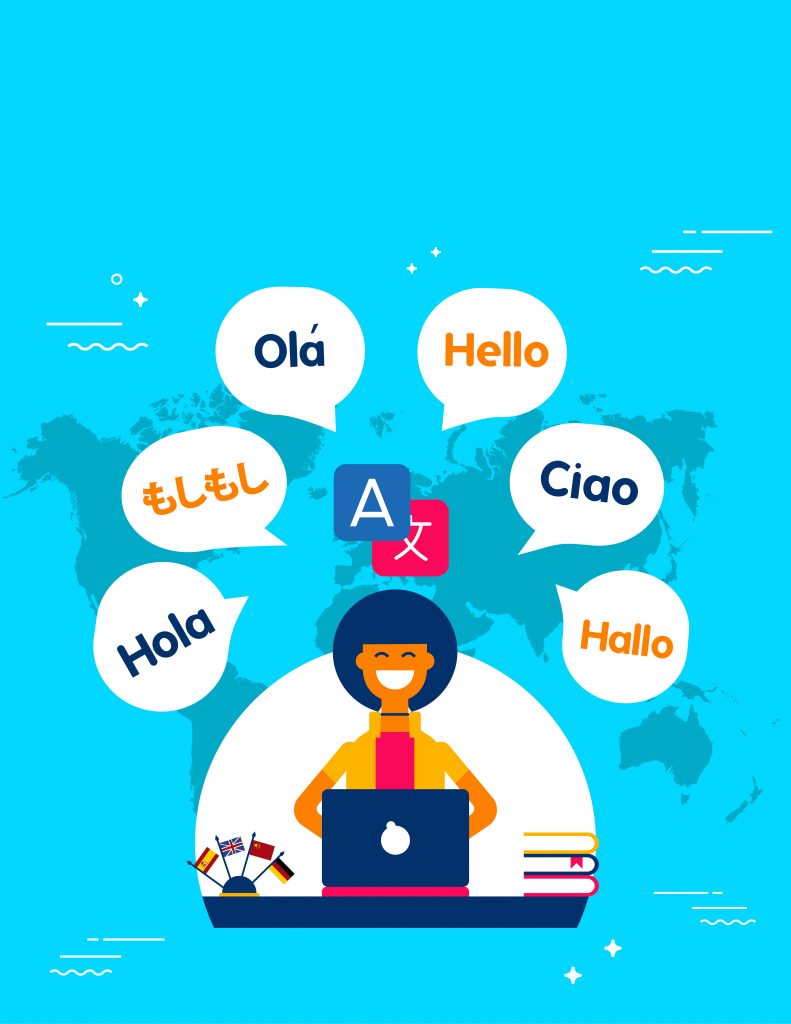
Translanguaging is a 21st-century way of thinking about language and the language practices of emergent bilinguals that takes a perspective of strength and is critical to designing effective and equitable instruction. Translanguaging creates a space for the bilingual person to bring their entire linguistic repertoire, the whole child, into the classroom. Although translanguaging is often described as a language practice—when bilinguals use two or more languages to communicate, translanguaging encompasses much more (Espinosa and Ascenzi-Moreno, 2021, p. 12).
Emergent bilinguals, or students who use two or more languages in their daily lives, are often thought to be in need of remediation. We reject this notion and instead offer teachers a strengths-based way to think and plan for literacy instruction for emergent bilinguals through translanguaging pedagogy. Translanguaging is both a theoretical stance and a pedagogical practice that has the potential to transform the education of emergent bilinguals. Translanguaging is rooted in the creative and critical process in which multilingual people use their language and other resources in dynamic, flexible, multimodal, semiotic, and purposeful ways (García, 2020). We strongly urge educators to take a stance in which we start with the languaging practices of the bilingual child.
Translanguaging starts with the child and is shaped by the ways in which he or she interacts with and makes meaning of texts. For example, when children respond to a text written in one language, they can be invited to respond using a language that allows them to reach deeper and more complex meanings. They can choose to write a draft using their home language even though the final piece will be in English. When responding to a text the teacher reads aloud, they can be paired with a child who speaks the same language and be invited to dialogue about the book in that language. Alternatively, they might engage in a project to which they bring their cultural and linguistic resources to craft a text for a particular audience. In each example, students are engaged in translanguaging. The core of translanguaging is that it centers and normalizes the bilingualism/multilingualism of students by valuing their varied ways of meaning making, which include the use of their linguistic, cultural, and multimodal resources.
This essay addresses the following questions: How do teachers create a space that normalizes bilingualism and multilingualism through translanguaging? What does it look like to center students’ language practices in literacy instruction? How do teachers enact translanguaging pedagogy in literacy practices?
In what follows, we offer readers an excerpt adapted from our book Rooted in Strength: Using Translanguaging to Grow Multilingual Readers and Writers (Espinosa and Ascenzi-Moreno, 2021) and focus on how a teacher intentionally crafts an author study in which emergent bilinguals experience translanguaging as a powerful and transformative resource in their literacy journeys. While the example features a bilingual teacher, Ms. Sun, all teachers who work with emergent bilinguals can engage in this type of intentional planning and instruction for emergent bilinguals that involves the whole child.
Ms. Sun teaches a second-grade bilingual class. She is committed to creating a classroom environment where being a reader is valued by everyone in the classroom community. She does this while sustaining the children’s bilingualism rather than pushing them to transition to only English. While Ms. Sun understands that children need access to their entire linguistic repertoire and need ample experiences with quality read-alouds, responsive guided reading lessons, engaging shared reading experiences, and agency in selecting books about topics that matter to them for independent reading, she is keenly aware that good readers also need to develop relationships with authors and therefore carefully plans an author study that children will be excited about and that allows for students to engage multilingually as they explore the author’s body of work and identities.
One of the ways that Ms. Sun structures an author study is by sharing her own reading life with the children. They know who her favorite authors are and they see her bringing these books to school. Ms. Sun demonstrates the power of her bilingualism by talking about books in Spanish and in English. Ms. Sun translanguages to demonstrate that bilingualism is an asset and a key tool to be able to access deeper meanings as readers, and, in this class, this is the norm. Throughout the year she introduces the children to the work of several authors representing diverse sociocultural and linguistic backgrounds who write for children (i.e., Juana Medina, Emma Otheguy, Jacqueline Woodson, Duncan Tonatiuh, Jorge Argueta, María Fernanda Heredia, and Derrick Barnes, among others). The children discuss their work as well as these authors’ language practices. In the example that we highlight, the class is studying the work of bilingual children’s (and adults’) author Pat Mora.
After reading aloud the book My Singing Nana (2019) by Pat Mora and talking about it, she introduces the children to her website (patmora.com/books/for-children). The class explores Pat Mora’s biography along with her collection of books and her ideas about being a writer. Ms. Sun has also researched Pat Mora’s life beyond the website (i.e., read interviews and articles, watched videos, etc.) and therefore has a lot of interesting information to share with the children about this bilingual author. The children are invited to share their thinking in Spanish and in English—that is, Ms. Sun invites them to capitalize on their entire linguistic repertoire. The children and Ms. Sun also examine the photographs of the books displayed on the website. She invites the children to read some of Mora’s titles while she points to the books she has on display in the front of her classroom. She tells them that they will be reading and examining these books, while also studying aspects of Mora’s life. The purpose of this inquiry and this discussion is to help them see Pat Mora not only as an important author but as someone the children can relate to because of her bilingualism, and as such see themselves as authors, just like Pat Mora.
Furthermore, Ms. Sun understands how important it is that the children have access to a diversity of voices, in particular voices of authors who in the past might have been silenced or rendered invisible. She understands that as their bilingual identities evolve, they will often occupy what Mary Louise Pratt (1991) coined as the “contact zone,” the borders “where cultures meet, clash, and grapple with each other, often in contexts of highly asymmetrical relations of power” (p. 34). Ms. Sun recognizes that her children will be influenced by the wisdom and ways of being that Mora portrays in her writing, as well as her writing craft as a bilingual author. They learn from Mora that words matter, that they can use them to transform and shape the lives they envision (Espinosa and Ascenzi-Moreno, 2021).
Throughout the author study, Ms. Sun creates charts as she takes dictation of what the children notice about Mora’s crafting techniques as an author who translanguages. She posts these charts in the classroom so the children can revisit them. Throughout the author study, the children write letters to Pat Mora, they take her books home to share with their families, they engage in dramatizations about some of her stories, they write bilingual book recommendations so others will learn about her work, and most importantly, they also write and illustrate their own stories. In all these literacy experiences, Ms. Sun invites them to translanguage.
These brief descriptions of Ms. Sun’s author study capture what happens when educators create room for emergent bilinguals to capitalize on their entire linguistic repertoire by translanguaging in intentional and purposeful ways. Educators like Ms. Sun create deliberate spaces for the lived experiences, school worlds, and languages of emergent bilinguals to intersect in ways that empower them and affirm who they are. As educators, we advocate for a vision in which bilingualism is the norm across diverse contexts, thus nurturing children’s literacy development regardless of the program the student is in (bilingual or otherwise). Our work with emergent bilinguals is guided by the following principles, which can be found in our book, Rooted in Strength (2021, p. 29):
“Listening, talking, reading, writing, and multiple modalities are tools for thinking, learning, wondering, and expressing that are central to the development of literacy(ies). To construct meaning fully, students need to leverage their entire linguistic repertoire in literacy events (e.g., reading, drawing, dramatizing, and talking about a poem).
“Students must have opportunities to engage with texts that allow them to participate in more complex and deeper thinking. Relying solely on the new language limits their ability to participate. In addition, children need access to texts that offer many perspectives and entry points.
“Students need to be involved right from the beginning in literacy events and to be encouraged to engage as thoughtful and critical thinkers, readers, writers, and creators. Translanguaging allows this engagement in learning to happen.
“Translanguaging opens doors not only for students’ linguistic repertoire but also for families’ and communities’ ways of knowing so they become partners in children’s literacy development. Translanguaging builds connections between the worlds of school, family, and community.”
As we conclude, we invite you to reflect on your own pedagogical experiences and the potential of making translanguaging a priority and the norm to truly benefit all students. What initial steps can you take as you move toward ensuring the whole child comes into the classroom as they engage in literacy learning?
References
Espinosa, C. M., and Ascenzi-Moreno, L. (2021). Rooted In Strength: Using Translanguaging to Grow Multilingual Readers and Writers. Scholastic.
García, O. (2020). “Translanguaging and Latinx Bilingual Readers.” The Reading Teacher 73(5), 557–562. doi:10.1002/trtr.1883
Pratt, M. (1991). “Arts of the Contact Zone.” Profession, 33–40. jstor.org/stable/25595469.
Mora, P. (2019). My Singing Nana. Magination Press.
Cecilia M. Espinosa is an associate professor at Lehman College, City University of New York, and Laura Ascenzi-Moreno is an associate professor at Brooklyn College, City University of New York. They are co-authors of Rooted in Strength: Using Translanguaging to Grow Multilingual Readers and Writers, published by Scholastic.















